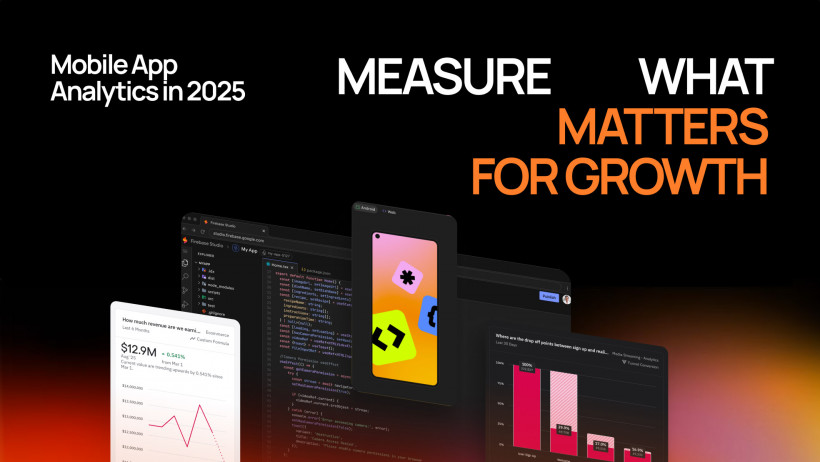Mobile apps are no longer just “nice to have.” They’re now the front doors of digital business, shaping how brands connect, deliver value, and compete. From retail and banking to fitness and entertainment, apps are where loyalty forms, purchases happen, and long-term relationships begin.
But here’s the catch: you can’t improve what you don’t measure. Even the most polished app can fail if you don’t understand how users experience it. That’s where mobile application analytics comes in — turning clicks, swipes, and sessions into insights about what customers need.
In 2025, the stakes are higher than ever. The market is crowded, users test multiple apps, and many are abandoned within 30 days. To stand out, you need to track behavior, measure performance, and act on real insights, not assumptions.
In this article, we’ll explore the essential tools, metrics, and strategies to turn raw data into growth, making your app not just another download, but a daily habit.
What Is Mobile App Analytics?
At its core, it’s the process of tracking, measuring, and analyzing user interactions within your app. Think of it as a window into your users’ minds: what they do, what they skip, and where they drop off.
Why it matters:
- Spot problems early – сatch crashes, bugs, or performance bottlenecks before they harm retention.
- Understand your audience – see how users navigate your app and what features matter most.
- Fuel growth – turn data into smarter product decisions, marketing strategies, and engagement campaigns.
What data can be tracked?
Modern mobile app analytics tools let you monitor nearly every touchpoint:
- App usage metrics like DAU/MAU (daily and monthly active users).
- Session duration and depth — how long users stay and what they do.
- Event-based analytics — tracking taps, swipes, or purchases.
- Crash reports and bug metrics to ensure stability.
- Cohort analysis — how different groups of users behave over time.
Key Metrics Every Business Should Monitor

Not all data points are equal. To measure app performance effectively, focus on the following core metrics:
1. Active Users (DAU/MAU)
How many people use your app daily and monthly? Tracking both helps you calculate stickiness (DAU ÷ MAU), showing whether users return regularly.
2. Retention Rate
User retention tracking reveals if people come back after day one, week one, or month one. High acquisition without retention is a money pit.
3. Session Length & Frequency
Understanding session duration and depth tells you how engaging your app is. Do users just open it for a quick glance, or do they stay and explore?
4. Conversion Rate and Funnel Drop-Offs
Conversion funnel analysis highlights where users abandon key actions—like signing up, completing checkout, or finishing onboarding.
5. Crash and Bug Reporting
No matter how polished your app looks, frequent crashes can kill user trust. Monitoring crash reports and bug metrics is critical for smooth performance.
Choosing the Right Analytics Tools in 2025
With dozens of platforms available, which ones should you use? The best choice depends on your goals, but here are the leading players in 2025:
Google Firebase

- Free and tightly integrated with Google services.
- Offers real-time app monitoring, event-based analytics, and crash tracking.
- Great for startups and small businesses looking for a cost-effective solution.
Mixpanel

- Known for advanced mobile user behavior tracking and conversion funnel analysis.
- Allows deep segmentation and cohort analysis.
- Ideal for teams that want to experiment and personalize user journeys.
Amplitude

- Focused on product analytics and user retention tracking.
- Provides clear visualization of user paths and cohorts.
- Popular among growth teams aiming to optimize engagement and retention.
Custom BI Dashboards

- For enterprise-level apps, integrating data into custom business intelligence dashboards can combine marketing, sales, and app usage metrics into one view.
- Offers flexibility and tailored KPI tracking.
Advanced Use Cases for App Analytics

Beyond the basics, mobile application analytics unlocks more sophisticated opportunities:
A/B Testing
Experiment with different onboarding flows, push notification timings, or pricing models. Analytics shows which variation performs best.
User Journey Optimization
Identify friction points in navigation and smooth them out. For example, if many users abandon checkout at payment, a simpler process could fix it.
Marketing Attribution
With attribution tracking, you know which campaigns, ads, or channels drive valuable users — not just downloads.
How to Act on Analytics Data
Data alone doesn’t drive growth, it’s what you do with it that counts. Here’s how leading teams put analytics insights into action:
Feature Prioritization
Use event-based analytics to see which features get the most love. Double down on popular ones, and cut what nobody touches.
UX Improvement
If session depth drops after a specific screen, that’s a red flag for poor usability. Redesign it to keep users engaged.
Targeted Push Campaigns
Combine cohort analysis with retention data to create personalized campaigns. For instance, re-engage users who haven’t opened the app in 7 days with a smart push notification.
Common Analytics Mistakes to Avoid
Even with the most powerful mobile app analytics tools, many teams stumble because they focus on the wrong things. Avoiding these common mistakes can save time, money, and frustration:
1. Tracking Too Much Without Clear Goals
It’s tempting to track every possible metric, after all, more data feels like more control. But in reality, data overload often clouds decision-making. Instead of chasing vanity numbers, focus on KPIs that tie directly to business outcomes such as retention, conversions, or revenue. Remember: tracking everything doesn’t equal understanding.
2. Ignoring Data Segmentation
Averages can be misleading. Looking at overall retention might suggest your app is healthy, but without segmentation, you may miss the fact that one user group is thriving while another is churning. Break data down by geography, device type, acquisition channel, or behavior cohort. Segmentation reveals hidden patterns that can inform targeted improvements.
3. Not Acting on Insights
Analytics reports don’t drive growth on their own, action does. Too many teams spend hours creating dashboards that never influence product or marketing strategies. The real power of analytics lies in closing the loop: use insights to test new features, refine campaigns, or improve UX, then measure again.
By sidestepping these pitfalls, you ensure that analytics becomes more than just a reporting tool, it becomes a strategic partner in growth.
How WEZOM Implements Analytics in Mobile Projects

At WEZOM, we’ve seen firsthand how mobile application analytics can make or break a project. Too often, companies treat analytics as an afterthought, something to plug in once the app is already live. By then, it’s usually too late: valuable early insights are lost, and product teams are left guessing.
That’s why our approach is different. We treat analytics as a core foundation of mobile development, not a “nice-to-have” add-on. Here’s how we do it:
- Set up analytics from day one – every app we build starts with a clear measurement strategy. From the very first user interactions, our clients gain visibility into what’s working and what’s not.
- Deliver KPI-driven reporting – numbers alone mean nothing unless they’re tied to business impact. We connect app usage metrics directly to growth goals like retention, revenue, and engagement.
- Encourage cross-functional data usage – developers, marketers, and product managers don’t work in silos. We ensure that analytics insights are shared across teams, creating a unified picture of user behavior and priorities.
- Adapt to evolving needs – as apps grow, so do their analytics requirements. We refine event tracking, add new reports, and adjust KPIs to keep insights relevant.

Conclusion: Analytics as Your Growth Engine
In 2025, apps truly live or die by how well they understand and serve their users. A sleek interface or clever marketing might earn downloads, but only data-driven insights will keep users engaged and loyal. This is where tools for mobile app analytics become your competitive edge, they empower you to track what matters, eliminate guesswork, and continuously optimize app engagement.
The most successful businesses aren’t those with the most data; they’re the ones that know how to turn data into meaningful action. Whether it’s refining a feature, improving onboarding, or launching smarter campaigns, analytics ensures every decision is backed by real evidence, not assumptions.
Think of analytics as more than dashboards and reports. It’s your growth engine, helping you understand your audience, anticipate their needs, and create an app experience they’ll return to again and again.
If you’re ready to move beyond the basics and unlock the full potential of your app, let’s talk. At WEZOM, we specialize in helping companies like yours measure app performance, prioritize the right features, and scale with confidence. With the right approach to analytics, your app won’t just survive the competition, it will thrive.

